2015 Audi A3 Quattro vs. 2014 BMW 228i, 2014 Mercedes-Benz CLA250 4MATIC
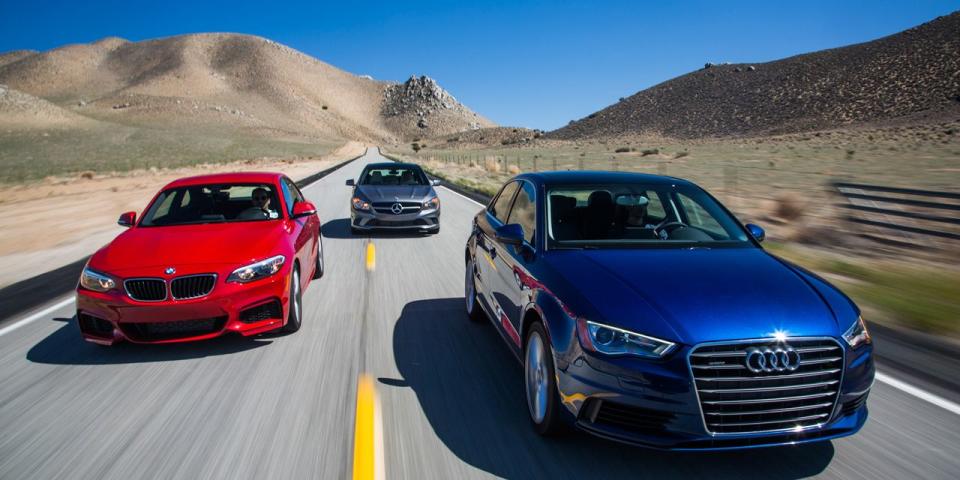
From the June 2014 Issue of Car and Driver
Seems like only yesterday that we were giving last rites to the compact-sports-sedan segment as its standard-bearers ballooned in dimensions, features, and price.
Does a BMW 3-series need to be the size of the old 5? Well, yes, now that the 5 is the new 7 and the 7 is the new battleship Bismarck. If you didn’t buy an Audi or a BMW or a Mercedes last year, it may not be a case of you leaving them, but of them leaving you and the rest of the just-doing-okay middle class.
Alas, some relief is on the way as the German luxury brands furiously backfill their catalogs to stay in the all-important $35,000 to $45,000 segment, where monthly payments can still be swallowed by average Jills and Johns. There’s already some commonality to the formula: turbocharged four-cylinder engines mounted transversely, dual-clutch automatic transmissions, and optional four-wheel drive. Mercedes leapt first with the swoopy CLA, and a new family of Audis will be launched around the core A3 sedan. Both the Benz and the Audi are on sale now, and we secured a pair of comparably priced four-wheel-drive versions.
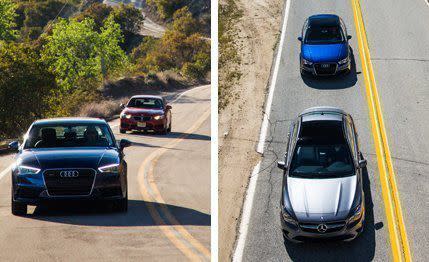
By cleverly moving parts-bin components around its vast chessboard, VW-Audi offers you what is essentially a GTI rendered as a four-door sedan. In fact, the Audi A3 1.8T starts at $30,795, right where VW Jetta pricing gets silly. See what you can get away with by having a luxury badge to throw on? Okay, there’s a bit more to it than that, with upgrades to the equipment and styling. If you want an A3 Quattro, add a 2.0-liter engine with 220 horsepower and $3000 to your bill. We had a few more extras, including the 18-inch wheels, power seats, and auto climate control of the $2900 Premium Plus package, plus the full MMI gear for $2600, for a total of $39,845.
While VW has been turning front-drive commuters into premium goods for years, Mercedes-Benz is a rookie. It could have simply issued a B-class with a trunk, but instead the CLA250 looks the part of a much larger and more expensive Benz, relying on the same coupelike visual themes that recently have proved so successful for Team Stuttgart. The CLA starts right next to the A3, at $30,825. Adding 4MATIC is only a $2000 hit, but the 208-hp 2.0-liter engine remains the same either way. Mercedes doesn’t do packages; its options are a la carte. Included in our $37,455 example was a $1480 sunroof, navigation equipment for $800, 18-inch wheels and tires for $500, and, amusingly, an illuminated grille star for $550.
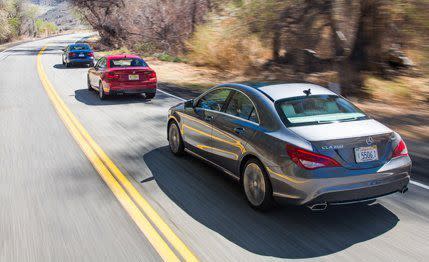
But what about that other German brand—you know, the one from Munich? Doesn’t it have a front-driver coming, even if no one at the company will confirm it? Indeed it does, in the 136-hp 2-series Active Tourer, which is based on the UKL platform that underlies the new Mini Cooper. But that 2-series is a quasi-minivan, a sort of German Pontiac Vibe, and we weren’t about to wait around for that.
Still, BMW does offer the 320i, a stripped-down 3-series priced to be an enticing distraction from all this front-drive madness. But because this test is aimed at those rooting around in the travel-size bins, we took the smaller, freshly redesigned 228i coupe as BMW’s representative. This is basically the old 1-series, that stubby bulldog of a two-door that excited purists but not aesthetes. It’s been updated for 2014 on the newer, compact rear-drive platform of the current 3-series, and agreeably restyled. The base price of $33,025 gives you a no-cost choice of a six-speed manual or an eight-speed automatic. To keep things level, we went automatic, though $5200 in options later, we had the M Sport package with 18-inch wheels and run-flat tires and a few other items to inflate the sticker to $38,225.
We hoped to learn through this chipmunk Olympics whether these venerable German brands have kept their core values intact despite the downsizing and price-cutting. And if the answer were simple, we could stop this right here.
The Mercedes doesn’t make a great first impression. You can’t help but notice that it’s not a traditional Benz, despite the gratuitous application of silver stars. The slippery lines meant to invoke luxury coupe-ness work well in the wind tunnel [see “Drag Queens,”] but get all bunched up in the nose, where the size-12 grille and blocky overhang push too much car ahead of the front wheels. Some companies, notably Honda, can shape their front-drivers to better hide the inelegance of a transverse layout. Not Benz; not yet, anyway.
Indoors, plastic abounds and Benz conventions are smashed by the dominant styling feature: a wavy panel of seashell or laminated ivory or space-station insulation—we’re not sure which—across the dash. It’s not necessarily unattractive, but it is risky. Unlike Audi, which made the A3 look steadfastly Audi-esque inside, Mercedes cut a different path for the CLA, excluding it from the family and serving it up as a daily reminder that you’re in that other Benz.

It doesn’t help that the 5.8-inch nav screen is tacked onto the dash like a wall-mounted TV hanging in a nail salon, its broad and garish black-plastic-frame insert showing you how big the screen might have been had you only spent more. Being relatively slow and devoid of map detail, the Becker-sourced nav unit has the feel of an older aftermarket cheapie, especially compared with the Audi’s thin seven-incher that motors up out of the dash when needed to shine out its detailed, high-res multicolor displays.
No, you have to get the CLA moving to experience its finer qualities. The car with the least horsepower and the heaviest curb weight here (3437 pounds) naturally turned in the slowest acceleration times, issuing a monotone hum that could be from any car west of Warsaw and east of Beijing. Yet the CLA seems quicker than it is when springing off the on-ramp on a surge of turbo torque, the seven-speed dual-clutch transmission always seeming to know which gear is needed when. The CLA doesn’t have a lot of power, but it has enough.
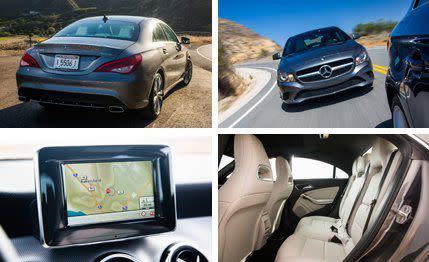
Mercedes gives the stiff and well-insulated CLA quick steering and excellent body control, which make for fast cornering speeds. On the skidpad, where it posted a healthy 0.93 g, it tucks in when you lift in a playful way that reminds us of Mazdas we’ve adored. The only dynamic flaw is a lack of wheel travel that produces a brittle ride. Where the Audi and BMW are sopping up the road fissures, the Benz driver is suffering.
You’ll suffer for the styling, too. The longest wheelbase in this test somehow does not equal the best back-seat comfort, and getting in there requires a duck under the low roof. Also, the front seats are fine but not as coddling or supportive as the BMW’s, our test favorites.
Benz could have made the CLA more practical with less of the needless flash. But we might have critiqued a mini E-class as dull and predictable. At least it would have supplied the orthodoxy practiced by the Benz family. Instead, this flamboyant CLA plays for newcomers, but against some very tough competition.
In this group, the 228i is the sportiest choice for people who don’t use back seats much and never carry more than four people. Just a few minutes of driving reveals a car that is definitely cut from BMW cloth, with connected and reactive steering and an engine that sings joyfully all the way to its 7000-rpm redline. You get strong brakes, an isolated cabin, and a structure that doesn’t shudder unless you’re T-boned by Amtrak.
Compared with the old 1-series, though, BMW’s new anchovy hews very closely to the company’s current thinking, which is to tamp down the overt sportiness in favor of greater luxury that will appeal to a wider audience. The suspension is suppler, and the steering is relatively light and a little less organic. Altogether, they’re small changes that many will not notice but some will equate with disaster.
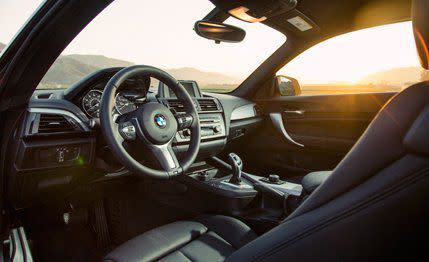
We wouldn’t go that far. This is an outstanding small automobile, a mini 4-series that delivers long-haul comfort while promising at least 21 mpg. The 2.0-liter clatters a bit at idle, but once it gets into a heated conversation with the eight-speed auto, things move. When it falters, it’s in ways that may not matter to many of you.
For example, at this lofty price you get Bluetooth phone connectivity, but you can’t stream music. For those few extra lines of software code you have to buy the $2150 Technology package, which throws in navigation and a few minor odds and ends. In our view, this is profiteering at its rankest. But if you don’t stream music or need factory nav, it won’t bother you.
BMW has been doing this for a while, needling its customers with airline pricing that piles on charges. Only two colors come at no extra cost: black and white. Every other hue is $550. The car in these pictures doesn’t have leather. If you want that, it’s a $4050 option. We don’t need it; the deep, highly supportive buckets are perfect as is. One good thing about this kind of pricing: Step carefully through the minefield and you get exactly the car you want. Aren’t compact sporty cars supposed to be frill-free? Isn’t that the whole reason we’re here, because the old “compacts” grew fat and decadent and expensive?
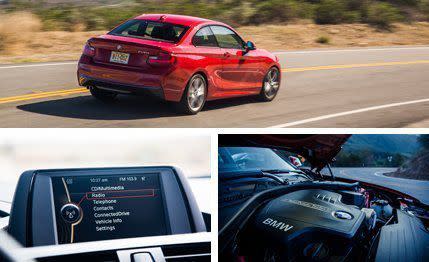
But the real reason the 228i finishes second in this test has nothing to do with pricing. It’s that the BMW enjoys every dynamic advantage in terms of curb weight, drivetrain configuration, power, and test-track speed, yet manages to be only fractionally more thrilling than the Audi. Some blame falls on the Bridgestone run-flat tires, which lack grip. Note how badly the 228i’s 0.86-g skidpad performance lags the others. On a fast road, the car can lose hold and start slipping sideways, something that only has to happen once to permanently shake a driver’s confidence.
If you’re willing to endure BMW’s prices and live with only two doors, you ought to get real passion in exchange. This BMW is good, but it’s not as great as it should be.
Audi has a massive head start in this game. VW has been doing this kind of premium front-driver for years, and the A3 lands running, a veteran at birth. Unlike the Benz, which poses as something grander while letting slip where the bucks were cut, the A3 seems confident about what it is and isn’t, and about who will buy it and how it’ll be used. It’s the revival of the automotive Swiss Army knife, the do-it-all small sports sedan that nobody has been able to build for a generation.
Styled inside and out to fit into the Audi lineup, the A3 is put together with studied discretion. The bargain bits don’t look it, and the materials make it feel authentically upscale. The motorized magnesium-backed LCD screen with its next-generation MMI controller beats even what’s in the A8. The A3 says: You’re not in the cheap Audi, just the small Audi.
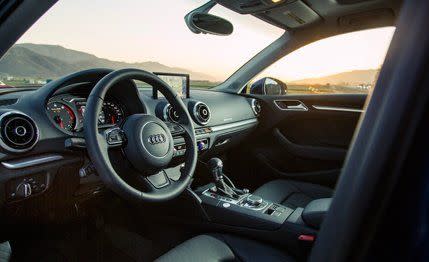
With an S3 coming for the piloti, the A3 positions nicely as a middlebrow runabout with swift reflexes and decent, torque-enriched power, but plenty of passenger comfort and suspension stroke to make all roads and destinations enjoyable.
Every inch of its skeleton—it has the shortest wheelbase by 2.1 inches—feels exploited to the utmost. The rear seats, snug as they are compared with larger cars, get the gold star for room and comfort in this group. True, the A3’s trunk is smallest on paper, but it has the largest opening, especially next to the Benz, whose teardrop taillights intrude into the lid cutout to prevent wider parcels from sliding in. As in the other two cars, the seats fold easily to expand the cargo area.
There’s a laid-back ease to the A3’s competence that we find wonderful. The thin-rimmed steering wheel with its white-stitched leather cuts the road like a coping saw, but the feedback is muted, as is the directional response to sudden throttle lifts or pitching pavement. The Audi is relaxed while making speed, and therefore you are, too.
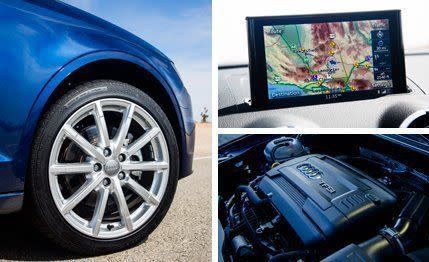
The A3’s power and performance fall in the middle of our group, though its skidpad number beats the others, thanks largely to the gummy Continental SportContact 2 tires that are a no-cost addition in the Premium Plus package. Those tires will cost a lot more than $0 to replace, unfortunately.
While the A3’s console is beautiful, it lacks the cubbies that Mercedes took pains to insert in the CLA. There’s no obvious place to park your smartphone except on the passenger seat or in the door pocket, and loose change gets a shallow dimple in front of the cup holders, but that won’t hold your coins for long. Unlike the other cars here, the Audi doesn’t supply you with shift paddles, curiously, so your right hand gets to visit the stick if you want to manually shift the S tronic dual-clutch six-speed.
Otherwise, this appealing micrometeorite fulfills its mission with effortless aplomb. This newly revived class of cars already has a benchmark.
You Might Also Like

 Yahoo Autos
Yahoo Autos 